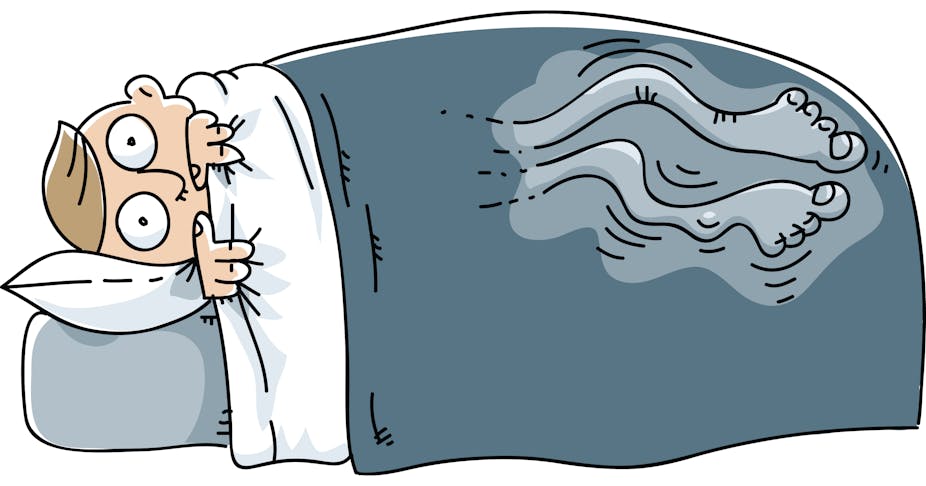Restless leg syndrome is a common affliction characterised by uncomfortable feelings in the legs accompanied by an irresistible urge to move the legs to relieve the sensations. People with restless leg syndrome often keep their legs moving by pacing or constantly moving their legs while sitting. The sensations commonly occur at night and have been described by patients as itching, throbbing, pulling, pins and needles or a creepy crawly feeling.
Onset of the sensations usually occur, or get worse, while the person is relaxed, sitting or lying down. Restless leg syndrome is known to affect both males and females of any age but is more common in women and older individuals. Misdiagnosis is not unusual since the symptoms tend to come and go and may be quite mild.
Causes
In many cases of restless leg syndrome the cause is not known. However, it is thought to have a genetic link as many who experience restless leg syndrome have relatives who also experience the sensations.
Restless leg syndrome has been associated with some medical conditions including Parkinson’s disease, diabetes and peripheral neuropathy (any damage or disease of the nerves that impairs sensation, movement or gland function depending on which nerves are affected).
It can also be seen in those with iron deficiency or poor kidney function. Some women experience restless leg syndrome during pregnancy. Pregnant women who experience restless leg syndrome usually find the symptoms occur in the third trimester, with symptoms ceasing within four weeks of delivery.
Research has shown restless leg syndrome is likely related to dysfunction of neural circuits of the basal ganglia (a group of structures at the base of the brain with links to the area that controls movement), which uses the neurotransmitter dopamine. Dopamine is needed to control muscle activity for smooth, purposeful movement, so disruption of the dopamine pathways leads to involuntary movements. Parkinson’s disease is also a disorder of dopamine pathways of the basal ganglia and Parkinson’s patients often experience restless leg syndrome.
Individuals with chronic kidney failure, diabetes or peripheral neuropathy usually find relief from restless leg syndrome with treatment of the underlying condition.
Symptoms of restless leg syndrome may also be aggravated by certain medications. These include anti-nausea drugs, antipsychotic drugs, antidepressants and some cold and allergy medications that contain sedating antihistamines. The intake of alcohol or lack of good-quality sleep often triggers the condition.
Diagnosis
There is no test for restless leg syndrome. The four criteria below are used to diagnose the condition:
symptoms worsen at night and are minimal in the morning
there is a strong urge to move the affected limb or limbs
symptoms are triggered when trying to rest or relax
symptoms are relieved by moving the affected limb, and return when movement stops.
The descriptions given by the patient provide important information about when and how often the symptoms occur, so triggers can be identified and avoided where possible. Family history also helps to provide clues about the cause of the symptoms and potential interventions for treatment.
Diagnosing restless leg syndrome in children is particularly challenging since children find it hard to describe their symptoms and where and how often they experience them. This sometimes results in misdiagnosis as growing pains or attention deficit disorder.
Treatment and prognosis
Doctors focus on relieving symptoms by identifying triggers and relieving factors, and the presence or absence of symptoms during the day. Often the symptoms will resolve with treatment of an underlying disorder such as diabetes or peripheral neuropathy.
Making changes to your lifestyle may affect mild or moderate symptoms. This might include stopping or reducing your intake of caffeine, alcohol or tobacco.
If the symptoms are related to a dietary deficiency in iron, folate or magnesium, the symptoms can be treated with adjustments of diet or supplementing the diet with the appropriate supplement. This may be identified through a blood analysis by a GP.
When symptoms are more severe or associated with an underlying disorder, it is very important to consult a GP, who may refer you to a specialist.
While there is no cure for restless leg syndrome, there are options for therapy and control of symptoms to increase periods of restful sleep. Symptoms generally increase with age and the rate of this increase varies greatly depending largely on the associated disorder.
Some people experience periods of remission, which may last a few days or months. However, symptoms will usually reappear.
It is important to note that a diagnosis of restless leg syndrome is not an indication of any other, more serious, disorder such as Parkinson’s disease.


